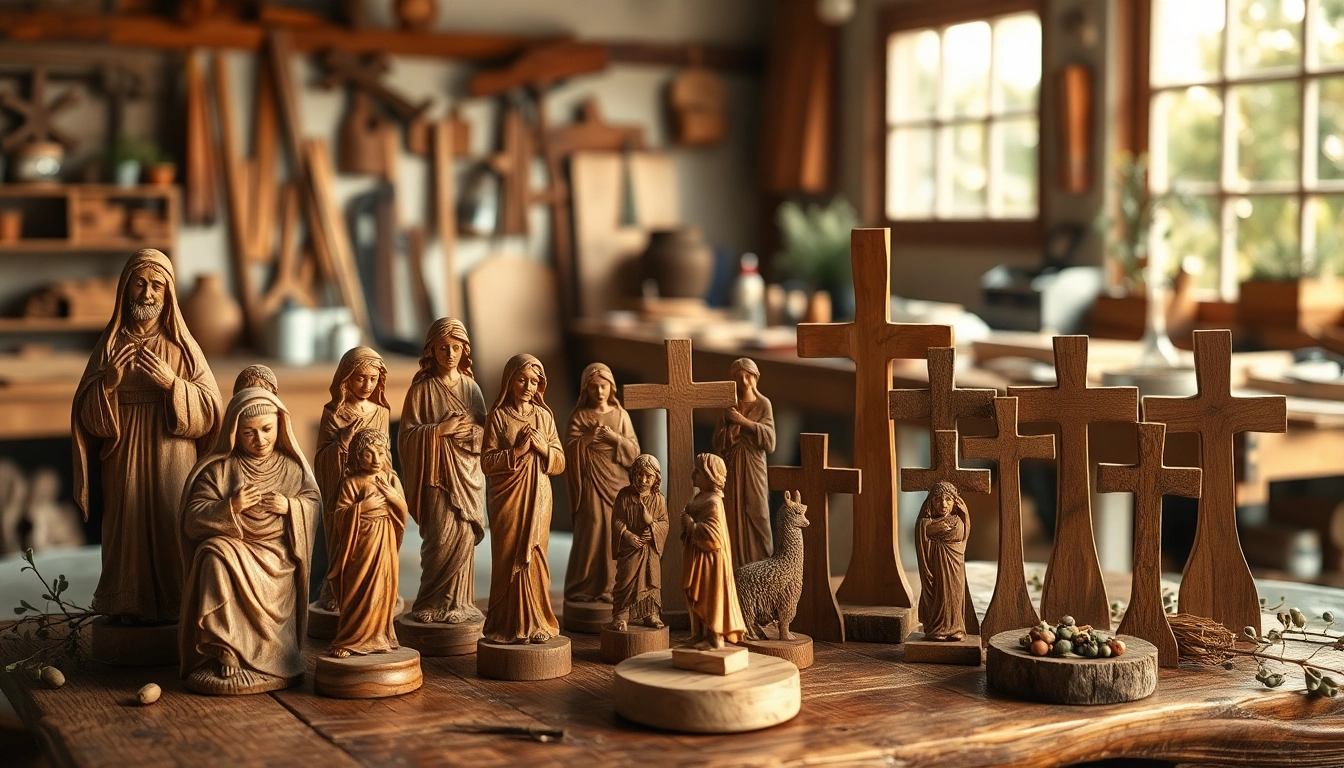The Unique Heritage of Olive wood carvings
Olive wood carvings represent a profound intersection of art, tradition, and spirituality, originating from the ancient lands of the Holy Land. Crafted from the timber of olive trees that have withstood the test of time, these intricate pieces embody not only the beauty of their material but also the rich heritage of the artisans who create them. With significant connections to cultural, historical, and religious contexts, the allure of Olive wood carvings transcends mere aesthetics. This article explores the history, significance, craftsmanship, diversity, and care of these remarkable art forms.
History of Olive wood carvings in the Holy Land
The tradition of carving olive wood dates back centuries in the Holy Land. It has its roots in the biblical era, where olive trees were seen as symbols of peace and prosperity. The cultivation of olives and the subsequent carving practices began in Bethlehem and spread to various regions around Jerusalem and other biblical sites. Artisans have meticulously honed their skills through generations, often starting as apprentices under master’s guidance to learn the delicate art of carving.
Historical records suggest that many of the earliest carvings were utilitarian, serving practical purposes within households and religious ceremonies. Over time, these handcrafted works evolved into decorative art forms, leading to the creation of intricate religious figures, nativity scenes, and crosses that are now synonymous with Olive wood carvings.
Cultural significance of Olive wood carvings
Olive wood carvings hold a special place in the hearts of many, particularly in Christian communities worldwide. They are symbols of faith, hope, and resilience, woven into the fabric of religious and cultural identity. These carvings often depict biblical stories, saints, and significant religious narratives, providing believers with tangible reminders of their faith and history.
Moreover, these art pieces serve as cultural bridges, allowing people from various backgrounds to connect with the heritage of the Holy Land. They are gifted on special occasions such as baptisms, confirmations, and weddings, signifying blessings and a connection to one’s faith.
Artisan techniques in Olive wood carvings
The artistry behind Olive wood carvings is a meticulous process that combines natural materials with skilled craftsmanship. Artisans start by selecting high-quality olive wood, often sourced from trees that have become too old or damaged for commercial olive production. This not only preserves the lifecycle of the trees but also respects the eco-system.
Techniques passed down through generations are employed in the carving process, including whittling, chiseling, and sanding. Each artisan possesses unique methods, often using hand tools that allow for greater precision and detail. The wood’s natural grain and patterns guide the carving process, ensuring each piece retains the distinct character of the olive tree.
Finishing touches involve applying natural oils and wax, enhancing the wood’s luster while preserving its quality. The result is a stunning piece of art that showcases the intersection of nature and human creativity.
Types of Olive wood carvings
Common figures in Olive wood carvings
Among the most sought-after Olive wood carvings are figures depicting biblical characters and themes. Commonly, artisans craft representations of Jesus, Mary, and various saints. These figures are often created with attention to detail, reflecting the spirit and significance of each character.
Animal figures, such as lambs and doves, also abound in Olive wood carvings, symbolizing peace, sacrifice, and the innocence associated with Christian beliefs. The incorporation of these figures in homes serves as a constant reminder of faith, spirituality, and the lessons imparted by these symbols.
Olive wood crosses and their meanings
Crosses carved from olive wood hold powerful symbolism in Christianity, representing the sacrifice and resurrection of Jesus Christ. The craftsmanship of Olive wood crosses can vary, ranging from simple designs to intricate, ornate patterns that demonstrate a high level of artistry and reverence.
Many believers choose to display these crosses in their homes or churches, serving as reminders of faith and hope. The unique grains and knots in the wood are often deliberately highlighted, creating a one-of-a-kind piece that resonates with individual spirituality.
Crafted nativity scenes from Olive wood carvings
Nativity scenes crafted from olive wood are particularly popular around the Christmas season, beautifully showcasing the birth of Jesus within the context of traditional craftsmanship. These scenes vary in complexity; some depict the Holy Family with accompanying angels and shepherds, while others may be simpler representations focusing on the manger and the infant Jesus.
For many families, displaying nativity scenes is a cherished holiday tradition, fostering reflections on faith and family during a festive season. The uniqueness of each handcrafted piece contributes to its appeal, making them not only decorative art but valuable heirlooms passed through generations.
Buying Guide for Olive wood carvings
Factors to consider when purchasing Olive wood carvings
When purchasing Olive wood carvings, consumers should consider several key factors to ensure they acquire authentic and quality pieces. Authenticity is paramount. Buyers should inquire about the origin of the wood and whether it has been sourced ethically from the Holy Land.
Quality of craftsmanship is another crucial aspect. High-quality carvings display fine detail and smooth finishes, indicative of skilled artisanship. It is advisable to carefully inspect the grain and texture of the wood, as these characteristics often reflect the individual style and skill of the artisan.
Additionally, buyers should consider the intended use of the carving—whether decorative, as gifts, or for personal use—determining the style and size that best suits their needs.
Where to find authentic Olive wood carvings
Finding authentic Olive wood carvings involves exploring trusted sources that prioritize craftsmanship and ethical practices. Artisanal workshops in Bethlehem, online marketplaces dedicated to handcrafted goods, and cultural exhibitions often showcase Olive wood carvings crafted by local artisans.
Participating in fair trade events and exhibitions can also be great opportunities to meet artisans, learn about their techniques, and purchase unique pieces directly, ensuring that consumers support the communities where these cherished artworks originate.
Understanding pricing for Olive wood carvings
The pricing of Olive wood carvings can vary based on several factors, including the intricacy of the design, size of the piece, and the reputation of the artisan. Generally, larger and more complex pieces command higher prices, while smaller, simpler carvings tend to be more affordable.
It’s essential to assess the balance between quality and price, ensuring that an investment in Olive wood carvings reflects not only aesthetic value but also support for traditional craftsmanship.
Maintaining your Olive wood carvings
Best practices for cleaning Olive wood carvings
Proper care and maintenance of Olive wood carvings can enhance their longevity and beauty. Cleaning should be done with a soft, dry cloth to avoid moisture damage, which can warp the wood or weaken the carvings over time. For deeper cleaning, a slightly damp cloth may be used, followed by immediate drying.
How to preserve the quality of Olive wood carvings
To preserve the quality of Olive wood carvings, they should be kept away from direct sunlight and extreme temperature fluctuations that can cause the wood to crack or fade. Regular application of natural oils can also help maintain a rich patina, enhancing the natural beauty of the wood.
Restoration techniques for old Olive wood carvings
For older Olive wood carvings in need of restoration, it is advisable to consult with professional conservators familiar with wooden artifacts. Minor repairs can often be made using wood glue for joints and cleaning agents safe for wood. However, restoration should be performed carefully to retain the original character and value of the piece.
Connecting with the artisans of Olive wood carvings
Profiles of prominent artisans in Olive wood carvings
Engaging with artisans who create Olive wood carvings can enrich one’s understanding and appreciation of the craft. Many craftsmen have their stories, showcasing their journeys through generations of artistic tradition. These artisans often take pride in their heritage, sharing insights into their techniques and the cultural importance of their work.
Community impact of Olive wood carvings
The production and sale of Olive wood carvings significantly impact the communities of the Holy Land. Artisanal work not only supports families but also fosters a sense of pride and identity among local populations. By purchasing these goods, consumers contribute to the sustainability of these age-old traditions, helping to preserve livelihoods and promote cultural heritage.
Visiting workshops and galleries for Olive wood carvings
For those interested in the artistry and craftsmanship behind Olive wood carvings, visiting local workshops and galleries can provide a unique experience. These visits offer an opportunity to see the carving process firsthand, speak directly with artisans, and appreciate the intricate details involved in creating each piece. Many workshops even provide workshops or lessons for those eager to learn about the art of carving.



